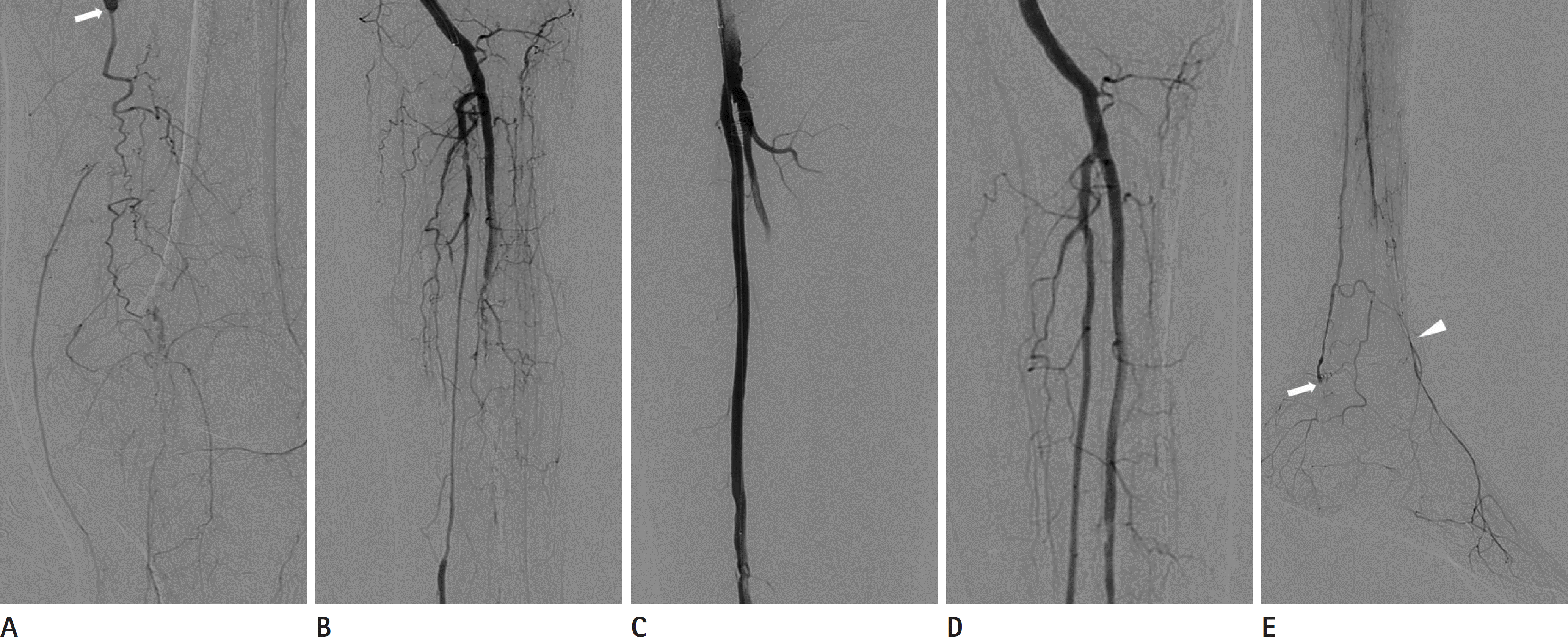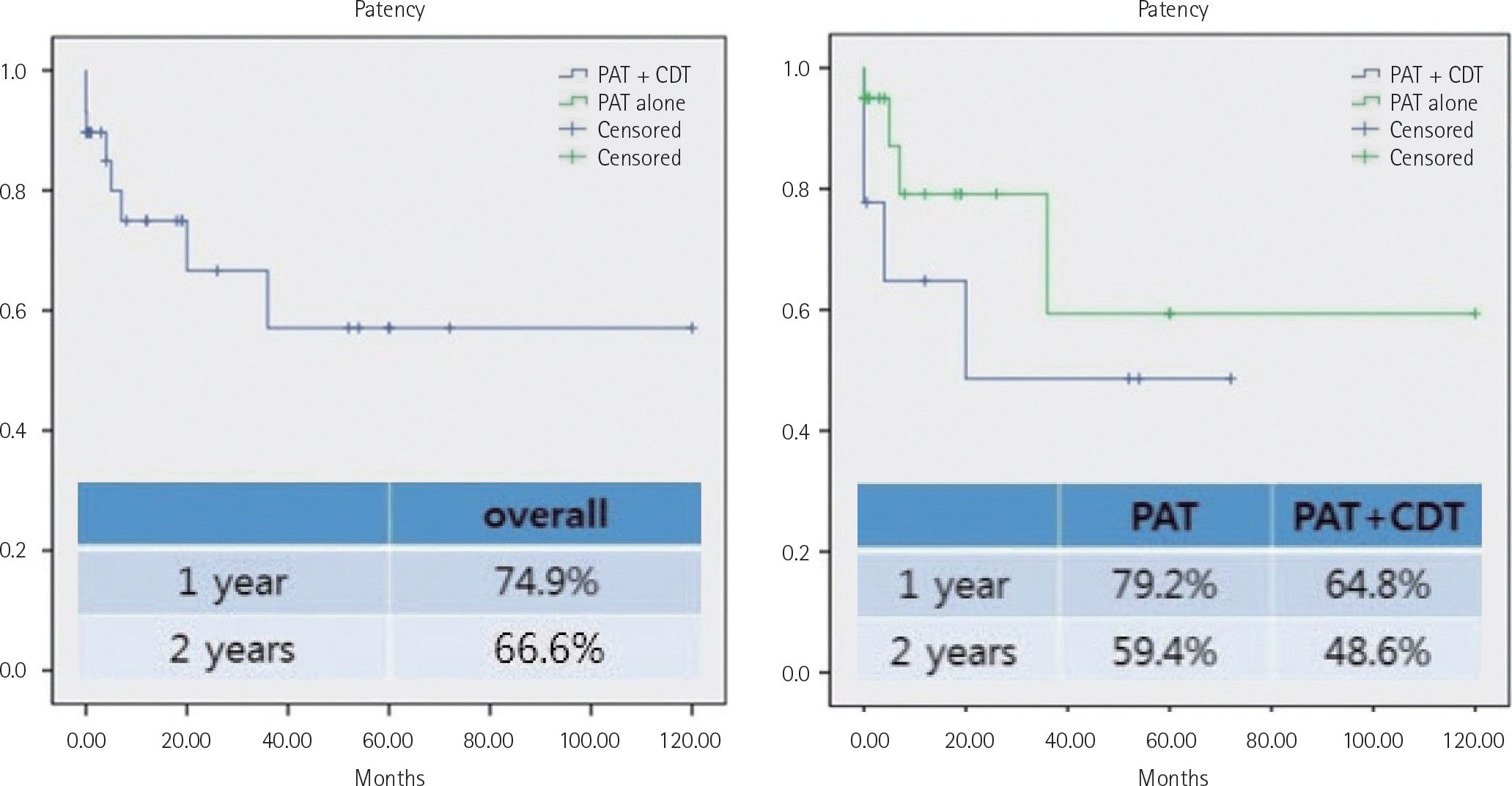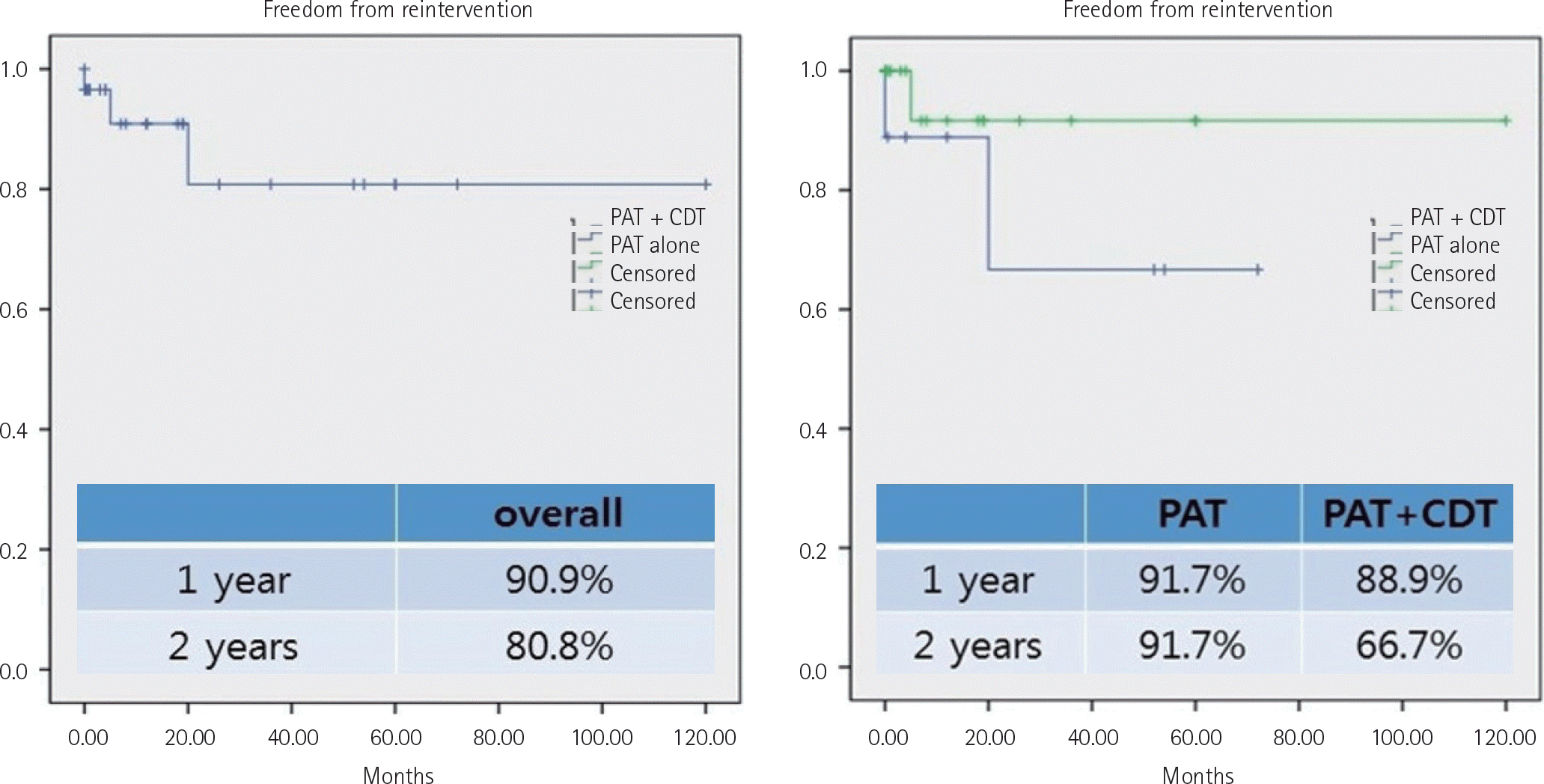Abstract
Purpose
To report the feasibility and longterm clinical outcome of percutaneous aspiration thrombectomy for treating acute or subacute arterial thromboembolism in the infrainguinal arteries.
Materials and Methods
Thirty limbs of 29 patients were enrolled in this retrospec-tive study between January 2004 and March 2014. Nine limbs underwent overnight catheter-directed thrombolysis followed by percutaneous aspiration thrombectomy (PAT). Eighteen limbs underwent PAT with adjunctive selective intraarterial thrombolysis in a single session. The remaining three limbs underwent PAT alone. Balloon angioplasty (n = 16) or stent placement (n = 3) was performed as required. In-hospital mortality and complications were estimated. The primary patency rate and the rate of freedom from reintervention were calculated using the Kaplan-Meier method.
Results
Technical success was achieved in 28 limbs. Clinical success was achieved in 27 limbs. The mean ankle-brachial index increased from 0.17 ± 0.26 to 0.98 ± 0.19 after the procedure. Three in-hospital deaths and no major amputations were recorded. Distal embolization of crural arteries occurred as a minor complication in five limbs, but no major complications occurred. The primary patency rate and the rate of freedom from reintervention were 74.9% and 90.9% at 1 year, respectively, and 66.6% and 80.8% at 2 years, respectively.
Go to : 
Index terms
Peripheral Arterial Disease, Angiography, Endovascular Procedures, Mechanical Thrombolysis, Thrombolytic TherapyREFERENCES
1. Results of a prospective randomized trial evaluating surgery versus thrombolysis for ischemia of the lower extremity. The STILE trial. Ann Surg. 1994; 220:251–266. dis-cussion 266-268.
2. Ouriel K, Shortell CK, DeWeese JA, Green RM, Francis CW, Azodo MV, et al. A comparison of thrombolytic therapy with operative revascularization in the initial treatment of acute peripheral arterial ischemia. J Vasc Surg. 1994; 19:1021–1030.

3. Ouriel K, Veith FJ, Sasahara AA. A comparison of recombi-nant urokinase with vascular surgery as initial treatment for acute arterial occlusion of the legs. Thrombolysis or Peripheral Arterial Surgery (TOPAS) Investigators. N Engl J Med. 1998; 338:1105–1111.
4. McNamara TO, Fischer JR. Thrombolysis of peripheral arterial and graft occlusions: improved results using high-dose urokinase. AJR Am J Roentgenol. 1985; 144:769–775.

5. Sniderman KW, Bodner L, Saddekni S, Srur M, Sos TA. Percutaneous embolectomy by transcatheter aspiration. Work in progress. Radiology. 1984; 150:357–361.

6. Og˘uzkurt L, Ozkan U, Gümüs¸ B, Cos¸kun I, Koca N, Gülcan O. Percutaneous aspiration thrombectomy in the treatment of lower extremity thromboembolic occlusions. Diagn Interv Radiol. 2010; 16:79–83.

7. Ansel GM, Botti CF Jr, Silver MJ. Treatment of acute limb ischemia with a percutaneous mechanical thrombectomy-based endovascular approach: 5-year limb salvage and sur-vival results from a single center series. Catheter Cardiovasc Interv. 2008; 72:325–330.

8. Moon SM, Kim IW, Jeon GS, Choi SY, Kim MD, Lee G. Endovascular intervention as management for acute limb ischemia, including the Rutherford class IIb ischemia: Korean Experience. J Korean Soc Radiol. 2016; 75:263–270.

9. Zehnder T, Birrer M, Do DD, Baumgartner I, Triller J, Nach-bur B, et al. Percutaneous catheter thrombus aspiration for acute or subacute arterial occlusion of the legs: how much thrombolysis is needed? Eur J Vasc Endovasc Surg. 2000; 20:41–46.

10. Karnabatidis D, Spiliopoulos S, Tsetis D, Siablis D. Quality improvement guidelines for percutaneous catheter-directed intraarterial thrombolysis and mechanical thrombectomy for acute lower-limb ischemia. Cardiovasc Intervent Radiol. 2011; 34:1123–1136.

11. Comerota AJ. Development of catheter-directed intrathrom-bus thrombolysis with plasmin for the treatment of acute lower extremity arterial occlusion. Thromb Res. 2008; 122(Suppl 3):S20–S26.

12. L⊘kse Nilssen GA, Svendsen D, Singh K, Nordhus K, S⊘rlie D. Results of catheter-directed endovascular thrombolytic treatment of acute ischaemia of the leg. Eur J Vasc Endovasc Surg. 2011; 41:91–96.
13. Swischuk JL, Fox PF, Young K, Hussain S, Smouse B, Castañe-da F, et al. Transcatheter intraarterial infusion of rt-PA for acute lower limb ischemia: results and complications. J Vasc Interv Radiol. 2001; 12:423–430.

14. de Donato G, Setacci F, Sirignano P, Galzerano G, Massaroni R, Setacci C. The combination of surgical embolectomy and endovascular techniques may improve outcomes of patients with acute lower limb ischemia. J Vasc Surg. 2014; 59:729–736.

15. White GH, White RA, Kopchok GE, Wilson SE. Angioscopic thromboembolectomy: preliminary observations with a re-cent technique. J Vasc Surg. 1988; 7:318–325.

16. Plecha FR, Pories WJ. Intraoperative angiography in the immediate assessment of arterial reconstruction. Arch Surg. 1972; 105:902–907.

17. Lipsitz EC, Veith FJ. Fluoroscopically assisted thromboembolectomy: should it be routine? Semin Vasc Surg. 2001; 14:100–106.

Go to : 
 | Fig. 1.Flow chart of patient selection. ALLI = acute lower limb ischemia, CDT = catheter-directed thrombolysis, CTA = CT angiography, DUS = Doppler ultrasonography, PAT = percutaneous aspiration thrombectomy, UK = urokinase |
 | Fig. 2.Angiograms of a 74-year-old male who presented with coldness and resting pain in the left leg for 7 days. He had undergone prior surgical embolectomy. Initial angiogram (A) shows occlusion from the distal superficial femoral artery (arrow) to the popliteal artery. Angiogram after aspiration of the thrombus and balloon angioplasty of the superficial femoral artery (B) reveals embolic occlusion of the crural arteries. After aspirating the thrombi in the crural arteries, the final angiogram shows good patency of the superficial femoral (C), proximal posterior tibial, and common peroneal arteries (D). Although the final angiogram of the foot (E) reveals distal embolization (arrow) at the distal posterior tibial artery, collateral flow is detected from the recanalized posterior tibial artery to the dorsalis pedis artery (arrowhead). Clinical success was achieved, and the ankle-brachial index increased from 0 to 1.16. |
 | Fig. 3.Primary patency curves. PAT + CDT: overnight CDT followed by PAT group, PAT alone: PAT with/without adjuvant thrombolysis in a single session group. CDT = catheter-directed thrombolysis, PAT = percutaneous aspiration thrombectomy |
 | Fig. 4.Freedom from reintervention curves. PAT + CDT: overnight CDT followed by PAT group, PAT alone: PAT with/without adjuvant thrombolysis in a single session group. CDT = catheter-directed thrombolysis, PAT = percutaneous aspiration thrombectomy |
Table 1.
Baseline Characteristics of Patients




 PDF
PDF ePub
ePub Citation
Citation Print
Print


 XML Download
XML Download